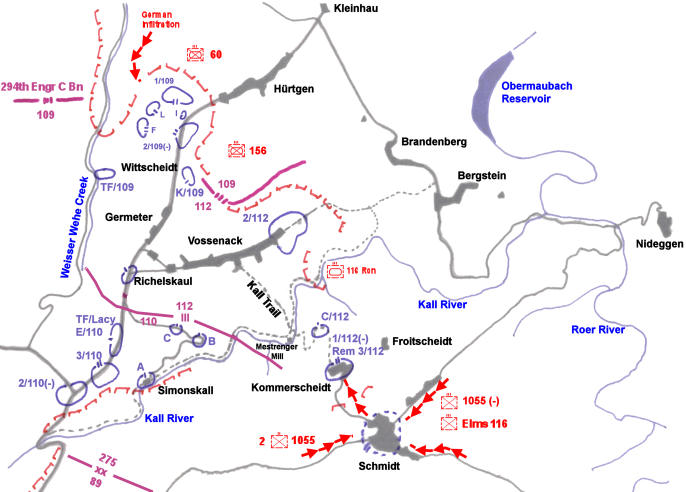in the Hurtgen Forest
Germany, 2 - 14 November 1944
(Rhineland Campaign)
THE COUNTERATTACK
By Major Paul A. Troup, Jr.
On 4 November 1944 the 112th Infantry received orders to hold their present positions so as to protect the east flank of the division. At 0600 hours the enemy reaction started with a severe shelling program on Kommerscheidt and Schmidt with the emphasis being placed on the former. At 0800 hours the enemy attacked with an estimated force of one battalion of infantry supported by 10 tanks but the position held and the attack repulsed. At 1000 hours the second German attack of approximately the same strength struck at the position from the northeast and southeast but the defenders of Schmidt were unable to hold and the battalion was forced to withdraw under pressure back to Kommerscheidt. Entire platoons of "K" and "L" Companies were cut off and although a few of these units got back to Kommerscheidt the majority of them were chopped into small groups and forced to surrender. The three tanks of Company "A" of the 707th Tank Battalion arrived at Kommerscheidt just as the 3rd Battalion started its withdrawal but too late to save Schmidt. Orders to recapture Schmidt, with the time of the attack set at 1500 hours, had to be cancelled when it was realized that the German attack had not been contained. At 1530 hours the enemy attack continued but was stopped before reaching Kommerscheidt by artillery, tanks, infantry, and air support. The three tanks of the 707th Tank Battalion engaged enemy armor supporting the attack and drove them back to the cover of Schmidt. The fighter-bombers on this mission claimed credit for destroying 3 enemy tanks. 25

4 November
"Later information indicated that the 1055th German Regiment of the 89th Division had been moving through Schmidt on its way to a rest center at Duren just prior to the attack. It was halted and ordered to counterattack at Schmidt. When supporting weapons arrived, 8 tanks and 4 self-propelled guns, this attack was started; the 3rd Battalion attacked Schmidt followed by the 2nd Battalion, both units received heavy losses." 26
During the morning of the 4th of November the Regimental Headquarters Company Commander of the 112th Infantry after receiving a two hour enemy artillery massage while on reconnaissance recommended that since the Germans were using Vossenack for an artillery impact area it would be advisable to either stay in the present command post in the pill box 800 yards west of Germeter or move to the southeast side of the Kall River where the enemy did not have direct observation. The Regimental Commander decided that the command post would remain in the pill box but a small operational group would be organized and move to the east side of the Kall River. The operational group was formed and in the afternoon moved by weasels to a hunting lodge on the southeast side of the draw but remained here only a short time because enemy patrol activity became very aggressive and there was insufficient personnel to provide adequate security. The Regimental Commander moved part of this group to the 1st Battalion Command Post in Kommerscheidt until an adequate shelter could be set up in the woods. While the command post was operating in the hunting lodge. Lt. Col. Flood, 3rd Battalion Commander, was wounded while waiting for orders. 27
In the afternoon prior to the moving of the command post, Lt. Col. Locket, Regimental Executive Officer, while enroute to a forward battalion command post, was captured by a German patrol as his party crossed the Kall River. Accompanying Lt. Col. Locket were Captain Montgomery, Regimental S-2, and two photographers who were detailed from US First Army Headquarters to make a pictorial record of this action. Captain Montgomery was wounded in the skirmish but the patrol later abandoned him in one of the many log bunkers in the area. Later he managed to work his way to the road where he was picked up and evacuated. 28
The 2nd Battalion in the meantime continued to hold its positions in Vossenack in the face of the precision fire of the enemy artillerymen. A counterattack at 1430 hours was beaten back with no loss of ground. 29
In addition to the identification of the 1055th Regiment of the 89th Division, the 60th and 156th Panzer Grenadier Regiments of the 116th Panzer Division were also identified as new arrivals to this front. 30
In the north the 109th Infantry made only small gains in its attack on the town of Hurtgen; advancing through minefields under heavy artillery fire. 31
The 1st Battalion, 110th Infantry enveloped the enemy's flank and succeeded in pocketing a section of the line of fortifications. 32
In this 24 hour period V Corps artillery fired 8054 rounds and the Tank-Destroyer units fired 2500 rounds in support of the division. 33
The unstable situation of the 4th of November was only slightly improved on the 5th of November when 8 medium tanks and 7 tank-destroyers traversed the Kall Valley. During the day the depleted remnants of the 1st and 3rd Battalions improved and consolidated their positions when they were not warding off small localized attacks or "sweating out" the numerous heavy artillery concentrations. The newly arrived armor knocked out several enemy tanks. It was evident that Kommerscheidt,being commanded by high ground on three sides, was not a good defensive position. In addition the enemy had infiltrated down the Valley of the Kall and was constantly threatening the only supply route, which due to the rain and the snow, had become almost impassable. Three tanks had already thrown their tracks in an effort to cross the draw. The engineers spent most of their days and nights fighting off or preparing to fight off these infiltrations, consequently there was little time remaining for them to repair or improve the trail. 34

